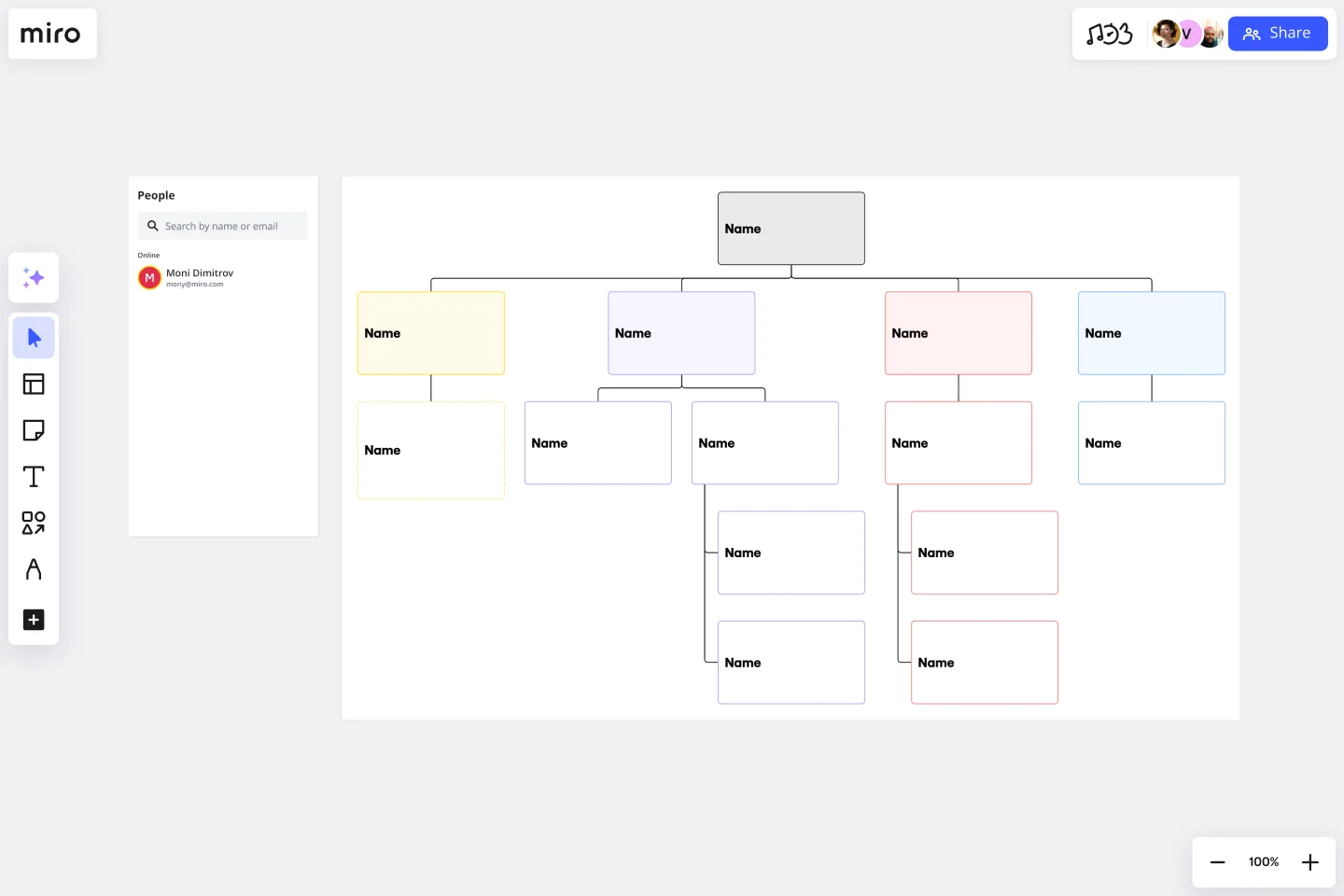Company Organizational Chart
Create a visual guide to the structure of your organization.
About the Company Organizational Chart template
A company organizational chart is a visual guide to how your organization is structured. It will generally reflect the reporting structure (who manages specific teams and people) and can be especially helpful for new employees to refer to as they familiarize themselves with your company.
Why should you use a company organizational chart?
In addition to showing the relations between employees at your company, you can also use a company organizational chart template to represent the structure of different departments or corporate functions inside your business.
When to use a company organizational chart template?
You can use your company organizational chart when planning employees’ career plans, managing HR resources, or any presentation you see fit.
How do you use the company organizational chart template in Miro?
Creating a company organizational chart is easy using Miro! Simply follow these easy steps to create an organizational chart that visually showcases your company structure:
Start with our pre-made company org chart template. Then, customize any elements you’d like, changing the sizes, shapes, and colors. For example, you may want to use colors or shapes to indicate people’s level of authority or department.
Write the names of the people inside your organization, as well as their roles and responsibilities. You can either just leave it in written form or add photos or other images to represent each person visually in your company organizational chart.
Invite your coworkers to collaborate in your company organizational chart template with you. Your company organizational chart can be a living document, and any changes you or your teammates make to the chart will be reflected in real-time.
If you are interested in learning all about organizational charts, and the various types and uses, you can read our comprehensive guide.
What are the four types of organizational structures?
The traditional four types of organizational structures. Functional: C-level is on the top of the structure, followed by senior management, management, etc. Divisional: where product lines and geography organize teams and people. Matrixed: people are organized in teams depending on the project/product they are working on Flat: where hierarchies are little to none and teams self-manage themselves. These are traditional company organization structures, but as we live in a more dynamic and decentralized work environment, those structures have been challenged and disrupted by new agile teams and businesses.
Where can I find a company organizational chart?
You can find a company organizational chart in our Templates Library or Miroverse.
Get started with this template right now.
Building Inclusive Organisations
Works best for:
Org Charts, Operations, Mapping
This board is made after running 4 months of research on Diversity, Equity, Inclusion & Belonging at fintech-unicorn Pleo, where we learnt what it takes to build a truly inclusive organisation.
Company Organization Chart
Works best for:
Org Charts, Operations, Mapping
The Company Organization Chart template enables clear visualization of hierarchical structures within an organization. It helps teams understand reporting lines, roles, and responsibilities, fostering transparency and alignment. With customizable features, such as color-coding and labeling, this template facilitates effective communication and decision-making across departments and levels.
Objectives and Key Results (OKRs) Template
Works best for:
Leadership, Strategic Planning, Project Planning
Clarity, focus, and structure — those are the key ingredients to feeling confident in your company’s directions and decisions, and an OKR framework is designed to give them to you. Working on two main levels — strategic and operational — OKRs (short for objectives and key results) help an organization’s leaders determine the strategic objectives and define quarterly key results, which are then connected to initiatives. That’s how OKRs empower teams to focus on solving the most pressing organizational problems they face.
Growth Experiments Template
Works best for:
Leadership, Desk Research, Strategic Planning
Many ambitious companies are eying the future and aiming to grow. But growth decisions can be leaps of faith that are risky and costly. That’s why growth experiments make so much sense. They offer a systematic six-step method that reveals which strategies are most effective, how they’ll affect your revenue, and how they compare to your past approaches. By helping you test out your strategies for scaling your business before you fully commit, growth experiments can save you serious time, resources, and money.
Dotted Line Org Chart Template
Works best for:
Org Charts
The Dotted Line Org Chart Template promotes transparency by demonstrating a dynamic representation of dotted line reporting relationships. This feature allows users to display both direct and indirect connections within an organization in a visual format, which offers a better understanding of how roles intersect and work together. By incorporating dotted lines seamlessly into the chart, this template goes beyond traditional hierarchical structures to ensure that complexities in reporting are fully communicated.
Data Org Chart
Works best for:
Org Charts, Operations, Mapping
The Data Org Chart template provides a visual representation of data-related roles and relationships within an organization. By mapping out data management responsibilities and dependencies, teams can enhance data governance and improve collaboration. With features for customizing data roles and connections, this template empowers teams to optimize data processes and ensure data integrity and compliance.
